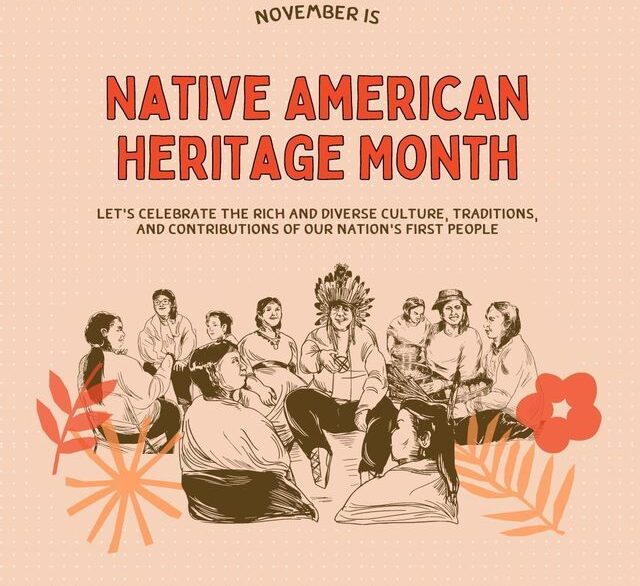🌎 Introduction: Honoring Roots That Run Deep
Every November, the United States observes Native American Heritage Month — a month-long celebration that not only acknowledges the rich history, culture, and contributions of Native peoples but also acts as a call for justice, respect, and recognition for the indigenous communities whose stories have too often been marginalized.
- 🌎 Introduction: Honoring Roots That Run Deep
- 📚 History of Native American Heritage Month
- 🗓️ Timeline of Recognition
- 📊 10 Amazing Facts About Native American Heritage
- ❓ Frequently Asked Questions (FAQs)
- 📌 Why is Native American Heritage Month celebrated in November?
- 📌 How can someone respectfully observe this month?
- 📌 Are all Native Americans the same?
- 📌 How does this observance help Native communities?
- 🧭 The Deep Significance of Native American Heritage Month
- 1. A Time to Correct Historical Wrongs
- 2. Cultural Preservation
- 3. Identity Empowerment
- 4. Environmental Wisdom
- 5. Healing and Solidarity
- 🎉 Observances and Cultural Traditions
- 💬 Heartfelt Wishing Messages
- 🌍 Importance in Our Lives and Society
- 🧠 Key Takeaways
- 🧩 Challenges Still Faced by Native Communities
- 🔚 Conclusion: Respect Is Not Seasonal
In a world driven by modernism and rapid digital evolution, Native American values of sustainability, spirituality, and kinship offer lessons for us all. This observance is not merely ceremonial — it’s a journey toward national healing, cultural appreciation, and inclusion.
📚 History of Native American Heritage Month
The story behind Native American Heritage Month is long overdue. Here’s how it unfolded:
🪶 Key Historical Milestones:
1915 – Dr. Arthur C. Parker (Seneca Indian and director of the Museum of Arts and Science in Rochester) urged Boy Scouts of America to dedicate a day to the “First Americans.”
1916 – The first official “American Indian Day” was declared by New York Governor Charles Whitman.
1976 – A week of recognition was declared by President Gerald Ford.
1986 – President Ronald Reagan proclaimed “American Indian Week.”
1990 – President George H. W. Bush declared November as Native American Indian Heritage Month, establishing it nationally.
Since then, every U.S. President has annually reaffirmed the importance of the observance through proclamations.
🗓️ Timeline of Recognition
| Year | Event |
|---|---|
| 1915 | Dr. Arthur C. Parker proposes an “Indian Day” |
| 1916 | First official observance by New York |
| 1976 | Gerald Ford acknowledges Native Week |
| 1986 | Reagan proclaims “American Indian Week” |
| 1990 | Bush Sr. designates November as Native American Heritage Month |
| 2020s | Growing advocacy for land acknowledgments, educational reforms, and tribal sovereignty |
📊 10 Amazing Facts About Native American Heritage
🌾 Over 574 federally recognized tribes exist in the U.S. today.
🛖 Native Americans have lived in North America for over 15,000 years.
📜 Indigenous languages are still spoken in over 100 communities.
🪶 “Thanksgiving” has different meanings; many Native communities honor it as a National Day of Mourning.
🧠 Native cultures contributed to modern medicine (e.g., willow bark → aspirin).
🧵 The Three Sisters farming method (corn, beans, squash) promotes soil health and sustainability.
🦅 The Bald Eagle, a national U.S. symbol, holds spiritual significance in many tribes.
🎵 Music, storytelling, and oral traditions have been preserved without written records for generations.
📚 The first Native American literary renaissance began in the 1960s.
📍Land acknowledgments are increasingly common at schools, universities, and events to honor indigenous lands.
❓ Frequently Asked Questions (FAQs)
📌 Why is Native American Heritage Month celebrated in November?
November was chosen to align with Thanksgiving, a complex holiday for Native peoples. It offers a chance to reframe narratives and emphasize indigenous voices and truths.
📌 How can someone respectfully observe this month?
Learn about tribal history, support Native-owned businesses, read Native literature, attend cultural events, and promote accurate education in schools.
📌 Are all Native Americans the same?
Not at all. There are hundreds of tribes each with unique languages, traditions, and histories. For example, the Navajo, Cherokee, Lakota, Hopi, and Iroquois have vastly different identities.
📌 How does this observance help Native communities?
It amplifies indigenous voices, encourages policy change, promotes education reform, and strengthens cultural pride and preservation.
🧭 The Deep Significance of Native American Heritage Month
1. A Time to Correct Historical Wrongs
Much of Native American history has been distorted or omitted. This month is a chance to teach the truth and recognize the atrocities committed during colonization.
2. Cultural Preservation
Tribal traditions, stories, and languages face extinction. November is a national stage to revive endangered knowledge and restore pride among indigenous youth.
3. Identity Empowerment
For many Native people, this month is a time of visibility. Representation matters — in media, education, government, and communities.
4. Environmental Wisdom
Native beliefs often include deep respect for the Earth, offering solutions to modern climate crises rooted in indigenous knowledge.
5. Healing and Solidarity
It invites non-Natives to become allies. Through acknowledgment, education, and empathy, bridges can be built between communities.
🎉 Observances and Cultural Traditions
| Activity | Description |
|---|---|
| 🧾 Land Acknowledgements | Recognizing tribal lands in schools/events |
| 📚 Educational Talks | Schools host tribal speakers and curriculum updates |
| 🎨 Art Exhibits | Museums and galleries showcase Native artists |
| 🍲 Food Festivals | Traditional Native cuisine events |
| 🪶 Powwows | Dance and music gatherings that celebrate community |
| 🎭 Storytelling Circles | Oral history sessions with elders and youth |
💬 Heartfelt Wishing Messages
🪶 “May this Native American Heritage Month remind us all of the enduring strength, wisdom, and spirit of indigenous peoples.”
🌎 “Honor the land, respect its stewards. Happy Native American Heritage Month!”
🌱 “May we grow in truth and unity as we celebrate the vibrant cultures of Native America.”
🫶 “Respect isn’t a favor — it’s a duty. Here’s to justice, pride, and heritage.”
🌍 Importance in Our Lives and Society
| Area | Impact |
|---|---|
| 🏫 Education | Encourages inclusive curriculums and historical accuracy |
| 🧠 Mental Health | Helps reduce cultural erasure trauma among Native youth |
| 👥 Social Justice | Fuels advocacy for tribal sovereignty and equity |
| 🌱 Environment | Revives sustainable practices from indigenous teachings |
| 🧵 Culture | Enriches American diversity and preserves ancient art forms |
🧠 Key Takeaways
✅ Observed in November annually
✅ Recognizes Native history, culture, and contributions
✅ Promotes truth-telling, education reform, and cultural healing
✅ Celebrated with storytelling, powwows, land acknowledgment, and art
✅ Encourages allyship, policy reform, and environmental respect
🧩 Challenges Still Faced by Native Communities
Recognition isn’t just about celebration — it’s about rights.
Many indigenous communities still battle:
High poverty and suicide rates
Missing and murdered Indigenous women (MMIW) crisis
Inadequate healthcare
Land loss and environmental degradation
Educational gaps and historical erasure
That’s why awareness must become action.
🔚 Conclusion: Respect Is Not Seasonal
Native American Heritage Month is more than 30 days on a calendar. It’s a lifelong call to listen, learn, and lift the voices of the original stewards of this land.
🌿 “The land remembers who it belongs to. So must we.”
Let us not just celebrate — but support, share, and stand with indigenous peoples — in November and always.








